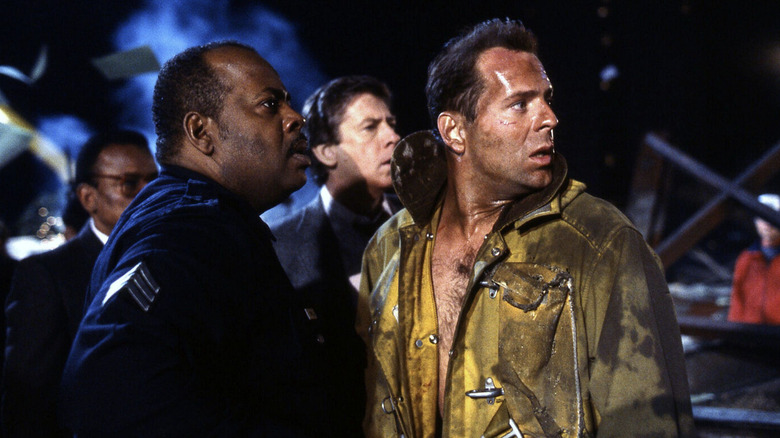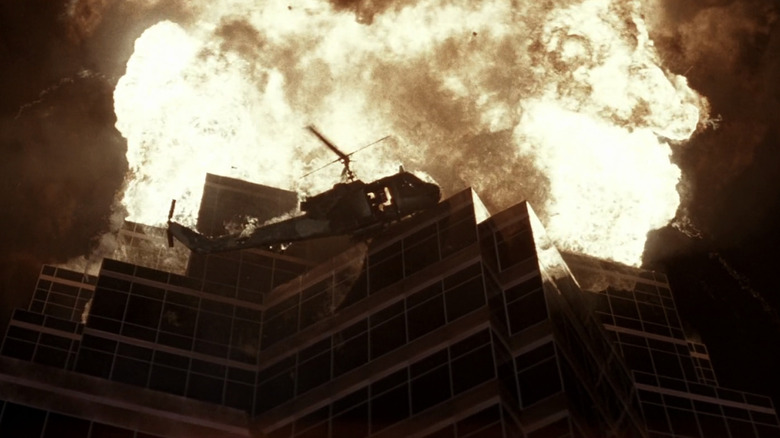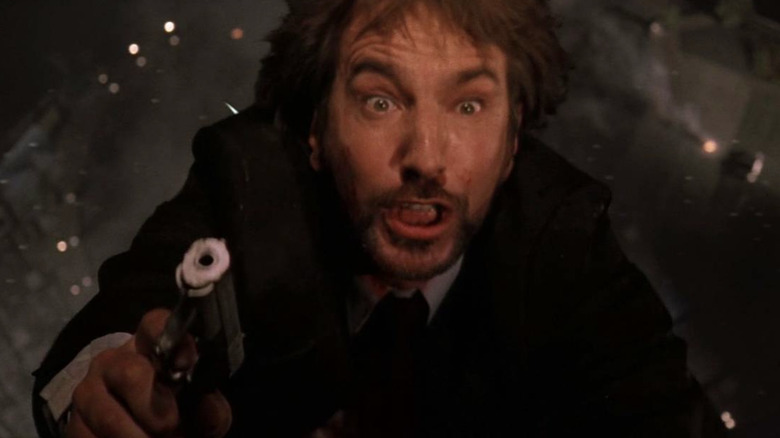Bruce Willis' First Day On Die Hard Was Also The Most Dangerous
Bruce Willis has never been one to shy away from roles that would require him to tackle some seriously madcap stunts. The series that immediately comes to mind is "Die Hard" of course, beginning with the very first installment, which premiered in 1988. It was a movie that completely rejuvenated the action film genre and kick-started Willis' career as the new everyman face of action heroes. But it also helped define the actor's appeal towards doing all his own stunts — and he couldn't have picked a better movie to learn a thing or two about the ins and outs of those dangers.
After all, most "Die Hard" films are themselves a veritable smorgasbord of visual effects mixed with seemingly perilous stunt work. But the first film in the series set the bar so high that subsequent films had a pretty hard time topping it while also keeping the realism factor well below "Fast & Furious." There are plenty of moments to choose from throughout the movie, but the explosion that rocks Nakatomi Plaza near the end definitely takes the cake. From the absolutely wild pyrotechnics to the sight of Willis jumping off a building only to swing back inside via a fire hose, the bonkers spirit of the stunt became a tenet of "Die Hard."
The big jump off Nakatomi Plaza was genuinely terrifying
Willis obviously wasn't actually going to dive off the roof of the Fox Building (the location used for Nakatomi Plaza) but he did need to jump off something. That something ended up being a five-story garage: an albeit far less cinematic but no less dangerous height to leap from. Speaking in 2007 with Entertainment Weekly, Willis painted a pretty nerve-racking picture of the moments leading up to the stunt. He quickly learned that a fear of heights or gravity's magnetic pull was far from the only thing he'd need to overcome — there was also an explosion.
"And I'm up there on the roof and they're strapping the firehose around my waist and they're slathering me up with this stuff and I said, 'What's this for?' And they said, 'That's so you don't catch on fire. See those big plastic bags of gasoline over there? We're gonna blow them up when you jump!' When I jumped, the force of the explosion blew me out to the very edge of the air bag I was supposed to land on."
After landing, Willis mistook all the people running towards him as a celebration for him nailing the jump when in actuality they were clamoring to see if he was still alive. The actor's belief that it was the pyrotechnics that sent him flying — as opposed to a badly aimed jump — isn't so far-fetched either. In an interview with Vulture in 2018, director John McTiernan described the "crazy machines" they built for the scene's explosive finale as "mortarlike devices" that needed to be transported via forklift. So it's not too surprising a couple of these fireball cannons sent Willis flying off-course. Luckily he dodged any serious injury, though he didn't escape the filming of "Die Hard" entirely unscathed.
Why they filmed Bruce's stunt first
Ambitious though he was McTiernan was also nothing if not practical. He knew shooting a scene that involved your lead actor leaping off a building for a stunt that featured heavily in the film's final act was risky. Once he successfully completed the jump, Willis rightfully had some questions — namely, why Tiernan chose to film the Nakatomi Plaza roof scene on their first day. After all, that's quite the stunt to throw at your lead actor on day one. The answer he got was probably a little less sugarcoated than it needed to be.
"They were like, 'If you were killed at the end of the movie it would cost us a lot more money because we'd have to reshoot the whole thing with another actor,'" Willis told Entertainment Weekly. It's a rather tongue-in-cheek but still sobering reminder that despite the many precautions taken to prevent accidents on set, they still happen. Even with safety measures in place, it was impossible to remove every potential risk. In a lot of ways, that's what they were doing by scheduling the stunt first: mitigating the damage an accident would have on the production of "Die Hard."
Why Bruce Willis did his own stunts
Given Willis' experience that first day of shooting, I don't think anyone would have faulted him for having second thoughts on how involved he wanted to be in doing his own stunts. But according to "Die Hard" cinematographer Jan de Bont, it actually had the opposite effect on the actor's previous reluctance. "In the beginning, Bruce didn't want to do [the stunts]," she told Movie Web. But then he realized that if he was the one doing the stunt there would be more cameras on him, which meant fewer takes for safety reasons, and therefore less work on his part.
"Actors like that because it means they don't have to do [the scene] over and over," Bont explained. An understandable goal considering more takes would've meant jumping off that five-story garage again — not exactly ideal. Bont also said the extra cameras had another effect in creating a kind of pressure on the actor to get the stunt right the first time, saying they're "more willing to take risks." Willis clearly was one inclined to take those risks — doing the Nakatomi Plaza jump on his first day was proof enough of that.
The fall of Hans Gruber
Fans of "Die Hard" know that Willis' leap off Nakatomi Plaza wasn't the only moment in the film where an actor found themselves at the mercy of gravity. The late, great Alan Rickman, who gave us a stellar villain performance as Hans Gruber, had to undergo something similar. The only difference is instead of jumping, Rickman was going to be dropped. Ever the gentleman, McTiernan demonstrated the stunt to the actor first. using himself as a guinea pig.
"I got up there and dropped onto some boxes below," the director told Vulture. "It felt instantaneous; I let go and the next thing I heard was a loud noise as I hit the bag. It seemed so fast, I almost had no time to say, 'Oh, I'm falling.' It's just BANG." But if anything his demonstration was a feint to get Rickman to feel a bit more relaxed about what to expect — and then McTiernan slipped in the knife.
Counting Rickman down from three, the director gave the order to drop him before finishing. "That's a standard thing when you want to catch the look of surprise on an actor's face," he said in defense, clearly quoting a rule from Alfred Hitchcock and Stanley Kubrick's list of ways to torment actors. Then again, there is an element of shock that evolves in Rickman's face as he falls has always been so captivating. "There's just no way he could fake that," McTiernan continued.
Fake what? The slow realization your director has just duped you into falling a split-second before you were ready? Because that's what's eternally engraved on Gruber's face as he perpetually falls from Nakatomi.




